Bear Creek & South Jackson - Garage Track Plan
Version 17
A Brief History of the Corvalis & Eastern
In the late 1800's the Corvalis and Eastern Railroad began building another
transcontinental rail line. They starter from Corvalis Oregon and began building
West to the Pacific Ocean (which they reached at Toledo) and East following the
North fork of the Santiam River. In 1893 they reached Idanha within 15 miles of
the summit of the Cascades. But 1893 was not a good year for them, the financial
panic stopped them cold. The line to Idanha became part of the Southern Pacific
system but was never pushed over the Cascades to Bend or Prineville. Today the
line is called the Mill City branch and extends
barely to the outskirts of Mill
City and the Frank Lumber Co.
But what if a newly formed Railroad Company shows up with
cash in hand and picked up the assets of the C&E for a song? With the trackwork
from Toledo through Albany and up the Santiam pass already complete (and without
the debt load of the C&E) the new Railroad completes the line
over Santiam Pass and on to Redmond with a SP&S connection,
across Eastern Oregon through Prineville
and Burns then terminating with a UP connection in Pocatello.
This is the basis for the second version of the BC&SJ.
Introducing the Bear Creek and South Jackson
The time is 1952. Railroads around the country are still healthy. Ike is President.
The lumber mills in the mountains are producing forest products at a prodigious
rate. The larger towns have other needs too (besides logs and empty lumber cars).
The SP still enjoys trackage rights up the Santiam pass but doesn't use them
as often now that the Cascade line is open. Still it's not an unusual sight
to see Black Widow F units and Cab Fowards battling the 2.7% grade to the summit.
The bridge across the Willamette River was seriously weakened in the spring floods of
'51 and a car float has been pressed into service (to avoid those extra charges from routing
across SP, SP&S, or OE bridges) while the BC&SJ bridge gets rebuilt.
The Toldeo line is feeding a steady stream of paper, freight and agricultural products
through Corvalis and across the car float to Albany where it is redirected off
to final destinations. The envisioned ocean going port at Toledo never happened
but there is enough traffic to keep the line to the coast open.
The BC&SJ Garage Division
Points West (staging)
The car float provides off layout staging for Corvalis and Toledo. Mostly lumber and
agricultural products.
Bear Creek Yard (North Albany)
The modeled portion of the line starts at Bear Creek yard in North Albany where
there are lots of rail-served local industries. From the Bear Creek yard tracks lead off
- north to Salem and Eugene (in lower level staging)
- west to the Willamette car float connecting with Corvalis
and Toldedo (on the Pacific)
- east to Mill City and the Cascade crossing
Shelburn
A short distance East of Albany the tracks intersect the East side line of the SP.
at Shelburn. In this universe there is no interchange here. Just a tower to keep
trains from T-boning each other.
Mill City
The tracks have done most of the easy route by the time they get to
Mill City.
Here are a number of saw mills and one of the several Santiam River crossings.
The crossing in question is via an antique Pin-connected Pratt Truss bridge.
This bridge is built with round cross section vertical and diagonal beams, split into
longitudinal sections with flanges on the edges. The flanges are riveted together
to give the members their circular cross section (this bridge is similar to one
in the California State Railroad Museum in Sacramento)
Detroit
After leaving Mill City the track clings to the side of the Santiam river until
reaching Detroit. The real life Detroit was relocated by the army corps of engineers
when the Detroit Dam on the Santiam was constructed. But on the model the flooding
is still a year away. In the meanwhile Detroit is a source of logs and a gravel
quarry that supplies much of the ballast used on the BC&SJ.
Sherman Jct
Marks the intersection of the Sisters Branchline with the BC&SJ main. There isn't
much here, an interchange track and another small sawmill.
South Jackson Yard (at Redmond)
The last modleled area is South Jackson which is a major yard area for the BC&SJ as well
as having a number of industries (perhaps too many for the locale and period but mine
and logging supplies have to come from somewhere?). The turning facitily here is a wye.
There is also an interchange between the SP&S (Oregon Trunk Line) and the BC&SJ.
Points East (staging)
Continuing further East, track reaches Prineville, Burns, and Pocatello all represented
by the upper level staging area - Bend (on the Oregon Trunk Line) is also represented
by staging).
Dealings with other railroads
When the BC&SJ ran short of cash in the early 1900's the SP became a part owner of the line
in exchange for trackage rights. Thus in 1952 it isn't
uncommon to see a set of Black Widow diesels or a Cab Foward or two (or a mix of
em) dragging a freight over the Santiam pass on BC&SJ track.
When the BC&SJ reached South Jackson/Redmond the SP&S (Oregon Trunk) was short of
motive power. The Oregon Trunk was pretty well entrenched in hearts and pocketbooks
of the local politicians and to allow the
BC&SJ to cross their tracks they made a power pool deal. So you'll sometimes
see SP&S units on the BC&SJ and BC&SJ units on the SP&S (if the SP&S tracks were
better modeled)
I'm fond of the SP and have sweet spots for the SP&S and GN. One of the nice things
about freelancing is the ability to "bend" history when it suits you!
In real life the C&E wound up in the hands of the SP and various short lines headed
West from Prineville and Bend. Who's to say it couldn't have happened this way?.
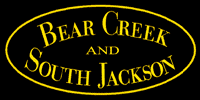





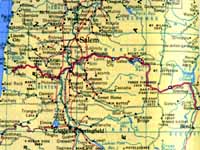

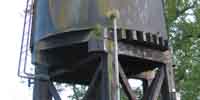
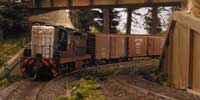
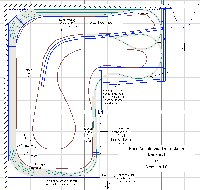
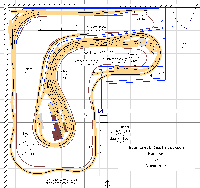
 Middle deck - Detroit/Idanha and Sherman Jct.
Middle deck - Detroit/Idanha and Sherman Jct.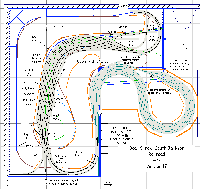 Upper deck - South Jackson yard and Pocatello staging.
Upper deck - South Jackson yard and Pocatello staging.